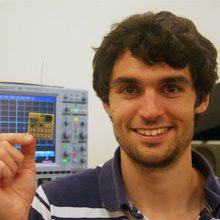This article is more than 1 year old
US student to fill heavens with Sprites
You too can have your own miniature satellite
A Cornell University postgrad student is offering enthusiasts the chance to get their own diminutive bit of kit into space, in the form of a miniature satellite.
Zac Manchester's Sprite is a solar-powered board "about the size of a couple of postage stamps", which packs a "microcontroller and a radio for communicating with ground stations from low Earth orbit".
![]()
The plan is to tease a swarm of Sprites into a standard CubeSat package, and blast them heavenwards – hopefully as part of NASA's Educational Launch of Nanosatellites (ELaNa) program.
 Zac (pictured) explained to El Reg: "We're trying to bring the cost of putting a satellite into low Earth orbit as low as possible. Up until now, only governments, militaries, and huge corporations have been able to launch spacecraft. CubeSats have brought space within reach for universities, but they still cost upwards of $100,000 to build and launch. We're trying to make space accessible to as many people as possible: high school students, hobbyists, ham radio clubs – anyone with a few hundred dollars and the desire to explore and experiment."
Zac (pictured) explained to El Reg: "We're trying to bring the cost of putting a satellite into low Earth orbit as low as possible. Up until now, only governments, militaries, and huge corporations have been able to launch spacecraft. CubeSats have brought space within reach for universities, but they still cost upwards of $100,000 to build and launch. We're trying to make space accessible to as many people as possible: high school students, hobbyists, ham radio clubs – anyone with a few hundred dollars and the desire to explore and experiment."
He added: "Spaceflight today is in many ways analogous to computing in the 1960s. It is mostly done by large organisations with access to huge and expensive hardware. By opening up spaceflight to much broader participation, exciting new ideas and applications are bound to pop up in the same way that they did in computing during the PC revolution of the '80s and '90s."
Zac is raising funds for his initiative down at Kickstarter, and has already attracted over $57k towards getting the thing off the ground. If the ELaNa gig doesn't work out, "we'll keep shopping around for a launch, possibly a commercial one if we have enough money", Zac said.
"Either way, we'll move forward with building KickSat as soon as the Kickstarter fundraising is over, since having flight hardware ready to go will help our chances of getting a launch," he noted.
If you fancy flying your own Sprite, 300 bucks buys you an orbiting board, transmitting the intials of your choice. You'll be able to track the satellite using "an ordinary Yagi antenna (the sort a ham radio operator might use), a rotator for pointing the antenna, a low-noise amplifier, and a software radio interface".
In case you were fretting, Zac assured us that after two to three weeks, the Sprites will burn up in the Earth's atmosphere, meaning headlines such as "Sprite downs ISS" won't be coming any time soon to a RSS feed near you. ®
